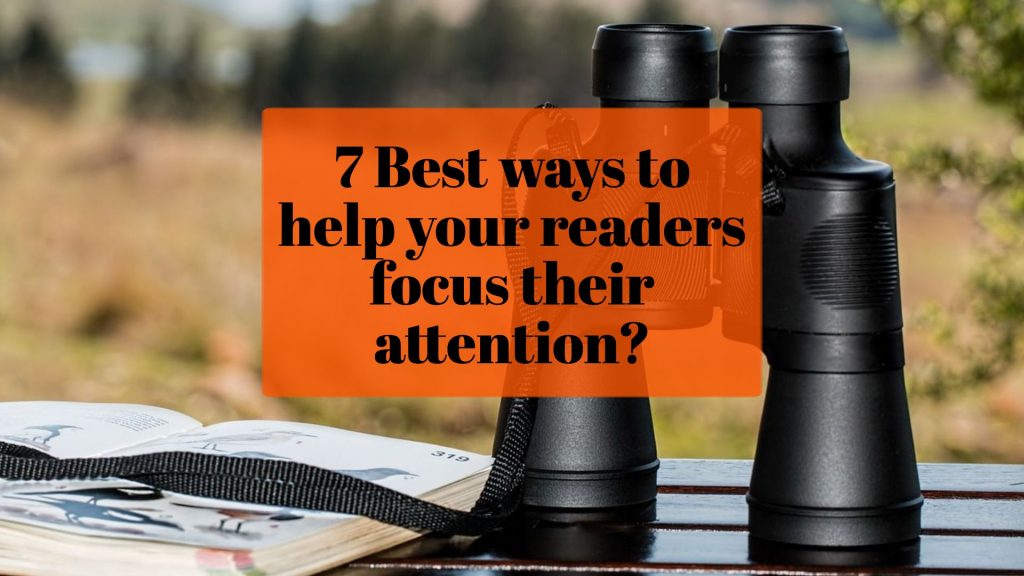Introduction: The importance of helping your readers to focus
A recent study found that the average person’s attention span has decreased from 12 seconds to 8 seconds over the past decade. This is a problem for content creators because it means that we have less time to engage our readers and capture their attention.
One way to help combat this issue is by being clear and concise in our writing. We need to make sure that our articles are easy to read and understand, or else we risk losing our reader’s attention before they even get to the meat of our article.
Another way to help keep our readers focused is by using strong visuals. People are more likely to remember information if it is presented alongside an image or video. This is why infographics have become so popular in recent years.
Finally, we need to be aware of the different ways that people consume content nowadays.
Attention span is dropping, but there are ways to help. With these 7 tips your readers will enjoy reading your content, rather than trying to skim through and scrape what they can from it.
Keep it Short: Readers will lose focus if they feel overwhelmed
Keep it Short: Readers will lose focus if they feel overwhelmed. The best way to help your readers focus their attention is to keep your article short and sweet. By keeping your article concise, you’ll help them stay focused on what you’re saying. If you find yourself getting long-winded, try to break up your paragraphs into shorter, easier-to-read chunks. This will make it easier for your readers to follow along and stay focused on your message.
Be Clear: State what you want readers to take away up front
When it comes to writing, capturing your readers’ attention is key. Whether you’re writing an article, blog post, or book, getting your reader invested in the content is essential for success. To help ensure that your readers focus their attention on what you have to say, here are 7 of the best ways to do just that.
The first actionable step for improving reader focus is to make sure your headline grabs their attention right away and gives them a clear idea of what they can expect from reading your piece. Using numbers or questions can be effective tools when crafting a compelling headline. Additionally, make sure that you keep paragraphs short and concise – long blocks of text are often intimidating and will likely lead readers astray.
If you want your readers to focus their attention, be clear about what you want them to take away. State your message up front, and make sure it is concise and easy to understand. Remember that people are more likely to pay attention if they know what they are supposed to be getting out of the experience. Keep in mind that stating your purpose upfront can also aid in reader retention.
Use Visuals: Images and infographics can help break up text and add interest
Images are a powerful tool that can help draw attention to important information and make it easier to understand. When used correctly, images and infographics can help break up text and add interest.
There are a few things to keep in mind when using visuals:
- Make sure the image is relevant to the topic at hand.
- Don’t overdo it – a few well-placed images are better than a page full of pictures.
- Choose images that are high quality and clear. Blurry or pixelated images will not help your readers focus their attention.
Be consistent: Use the some tones on voice
If you want your readers to focus their attention, then you need to be consistent with the tone of your voice. By using the same tones throughout your piece, you will create a sense of unity that will keep your readers engaged. Here are some tips for using tone in your writing:
1. Use a consistent tone throughout your piece.
2. Use different tones to create variety, but don’t overdo it.
3. Use appropriate tones for your audience and purpose.
4. Be aware of the connotations of the words you use.
5. Pay attention to the overall effect of your tone.
6. Make sure that your tone is appropriate for the genre you’re writing in.
Tell a Story: People are more likely to remember a story than a list of facts
People tend to remember stories better than lists of facts. This is because stories are more engaging and memorable. When you’re trying to help your readers focus their attention, telling a story is one of the best ways to do it.
Here are some tips for telling a story that will help your readers focus:
1. Make sure your story has a clear beginning, middle, and end.
2. Use strong descriptive language to paint a picture in your reader’s mind.
3. Use characters and dialogue to bring your story to life.
4. Keep your story interesting by using suspense and surprises.
5. Make sure your story is relevant to your reader’s interests and needs.
Use Humour: A little bit of humour can go a long way in keeping people engaged
Whether you’re giving a presentation or writing an article, injecting some humour can be a great way to keep your audience engaged. Here are some tips on how to use humour effectively:
1. Know your audience – make sure your jokes are appropriate for the people you’re speaking to.
2. Timing is everything – don’t try to be funny when it’s not appropriate, such as during a serious moment or when someone is sharing difficult news.
3. Use self-deprecating humour – making fun of yourself can endear you to others and take the pressure off of them to laugh at your expense.
4. Be aware of cultural differences – what may be funny in one culture may not be in another, so be careful not to offend anyone.
5. Don’t be afraid to try new material – if you’ve got a joke that isn’t well received, try changing it or leaving it out next time.
6. Appreciate that you might fail – keep in mind that your jokes are not for everyone. It’s OK to laugh at yourself if a joke doesn’t go over well, as long as it isn’t too embarrassing.
Be relatable: Write like you’re talking to a friend, not like an academic
When you’re writing an article, it’s important to remember who your audience is. You want to write in a way that’s relatable and easy to understand, not like you’re talking to a professor. Here are some tips to help you do just that.
First, use simple language that everyone can understand. Avoid using big words that will make your readers feel lost.
Second, write like you would talk to a friend. pretend you’re having a conversation with someone and let your personality shine through. This will make your readers feel more connected to you and engaged in what you’re saying.
Lastly, don’t be afraid to be informal. Use contractions and slang if it feels natural. This will help your readers feel like they are right there with you, having a casual chat.
Conclusion: these tips should give you the following benefits
If you’re looking for ways to help your readers focus their attention, look no further. These seven tips that I have outlines above will ensure that your readers stay engaged with your content.
Let’s stay connected **
My website: WPGOSOCIAL.com is a web development and marketing company. We specialize in helping Small Businesses develop credibility and brand awareness.
Quora: Question and answer with Romeo Clennon founder of WPGOSOCIAL.com; about web design, web hosting, marketing, SEO and more.
Pinterest: For marketing infographics, funny videos and more.
Stop by just to say hi, or come check out the great content on our other platforms.




